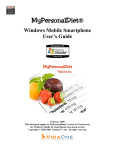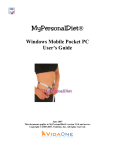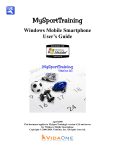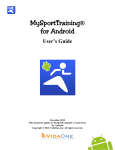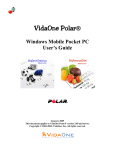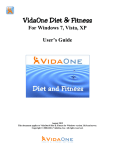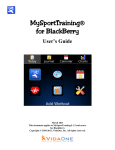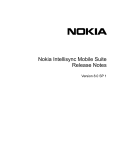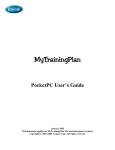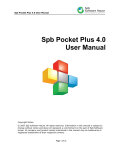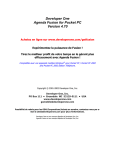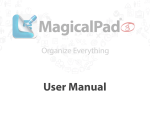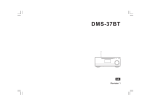Download VidaOne MyPersonalDiet User`s guide
Transcript
MyPersonalDiet® Windows Mobile Pocket PC User’s Guide February 2010 This document applies to MyPersonalDiet® 5 for Windows Mobile Pocket PC (touch screen) Copyright © 2005-2010, VidaOne®, Inc. All rights reserved. Table of Contents 1 2 3 4 5 Introduction ................................................................................................................. 4 1.1 What Is MyPersonalDiet®? ................................................................................ 4 1.2 Windows Mobile Compatibility ......................................................................... 5 1.3 How About Exercising? ...................................................................................... 6 1.4 VidaOne GPS ...................................................................................................... 7 1.5 VidaOne Polar ..................................................................................................... 7 1.6 VidaOne Diet & Fitness for Windows 7, Vista and XP ..................................... 8 1.7 Installation and Registration ............................................................................... 9 Installation................................................................................................................... 9 Running MyPersonalDiet.......................................................................................... 10 Trial Mode ................................................................................................................ 10 Registration ............................................................................................................... 11 Upgrades ................................................................................................................... 11 1.8 Technical Support ............................................................................................. 11 Setting Your Goals .................................................................................................... 12 2.1 Entering your Profile......................................................................................... 12 2.2 Weight Goal ...................................................................................................... 12 2.3 Duration ............................................................................................................ 13 2.4 Diet Summary ................................................................................................... 13 Choosing a Diet......................................................................................................... 14 3.1 Diet Plan............................................................................................................ 15 3.2 Nutrients ............................................................................................................ 15 3.3 Energy ............................................................................................................... 15 3.4 Meals ................................................................................................................. 16 Meals, Workouts and Health records ........................................................................ 17 4.1 Entering Meals .................................................................................................. 18 Quick Meal................................................................................................................ 18 Entering Food Items .................................................................................................. 18 Food Browser ............................................................................................................ 19 Favorite Food Items .................................................................................................. 21 Searching Food Items ............................................................................................... 22 Combining Food Items Into Dishes .......................................................................... 23 Enter Your Own Food Items ..................................................................................... 23 Enter Additional Servings ......................................................................................... 24 4.2 Entering Workouts ............................................................................................ 26 4.3 Entering Health Records ................................................................................... 28 Monitoring Your Diet ............................................................................................... 29 5.1 Today Plug-in.................................................................................................... 29 5.2 Today View ....................................................................................................... 29 5.3 Day view ........................................................................................................... 30 Daily Summary ......................................................................................................... 30 Diet Summary ........................................................................................................... 31 Meals, Workouts and Health Journal ........................................................................ 31 5.4 Month view ....................................................................................................... 32 5.5 Report View ...................................................................................................... 33 MyPersonalDiet for Windows Mobile Pocket PC User’s Guide 2 6 7 8 9 5.6 Charts View ...................................................................................................... 34 5.7 Getting Results .................................................................................................. 35 Exporting Meals, Health records and Workouts ....................................................... 37 Making a Backup ...................................................................................................... 38 Options ...................................................................................................................... 39 8.1 General .............................................................................................................. 39 8.2 Profile................................................................................................................ 39 8.3 Health ................................................................................................................ 40 8.4 Display .............................................................................................................. 40 8.5 Nutrients ............................................................................................................ 41 8.6 Markers ............................................................................................................. 41 8.7 Password ........................................................................................................... 41 8.8 Other ................................................................................................................. 41 What To Do Next? .................................................................................................... 42 MyPersonalDiet for Windows Mobile Pocket PC User’s Guide 3 1 Introduction 1.1 What Is MyPersonalDiet®? Most if not all health-conscious people spend a considerable amount of time and energy tracking the food they consume, and for various reasons, such as: • • • • To maintain, lose or gain weight To consume enough of some nutrients To limit their consumption of some nutrients To follow a balanced diet MyPersonalDiet is designed to help you establish a diet and weight goals, enter the data that matters to you (food, health and workouts), track that data and monitor your condition. This is an ambitious application that is focused on assisting you reaching your goals. Figure 1: MyPersonalDiet Day view presents key information about your diet, such as daily energy summary (left) and diet summary (right). MyPersonalDiet consists of four views, described later in this manual: • • • • The Day view shows relevant information for the day, and allows you to enter meals, health data, workouts, revisit your goals, set your diet and get results. The Month view shows a calendar that displays if your weight is on target or not for each day. The Report view presents various summary lists. The Charts view allows you to see various charts. MyPersonalDiet for Windows Mobile Pocket PC User’s Guide 4 1.2 Windows Mobile Compatibility MyPersonalDiet for Windows Mobile Pocket PC is designed and certified 1 for Windows Mobile 5 and 6 (including 6.5) for Pocket PC (touch screen) devices, in portrait and landscape, in regular or high-resolution including WVGA (400x800). Figure 2: MyPersonalDiet runs at ease in portrait and landscape, at either normal or high resolutions, on Pocket PC running Windows Mobile 5.0 and Windows Mobile 6.x. 1 Mobile2Market Windows Mobile Certification by Microsoft® MyPersonalDiet for Windows Mobile Pocket PC User’s Guide 5 1.3 How About Exercising? Dieting is not only about food and diet tracking, but also exercising. For this reason, VidaOne also offers MySportTraining (see Figure 3), the best-selling, award-winning, most comprehensive fitness software for Windows Mobile. Figure 3: MySportTraining is the premier fitness application for your Windows Mobile device and works hand in hand with MyPersonalDiet. MySportTraining offers a variety of features that complement MyPersonalDiet: • • • • • • • • You can track aerobic (cardio-vascular) and strength training workouts. You can use one of the predefined activities or create your own. You can track workout in details, and it even calculates the amount of calories you burn while exercising. It’s a must at the gym, because you can choose from pre-defined exercises (illustrated), purchase additional exercise series (also illustrated) or add your own exercises (and optionally attach pictures to them). It features a body chart that highlights the various muscle groups. You can tapand-hold any muscle group to get a list of exercises to add variety. The month view shows all your workouts at-a-glance to appreciate your accomplishments. The month view shows all your workouts at-a-glance to appreciate your accomplishments. The report view presents key information and rewarding summaries. The chart view shows a variety of motivating charts to see your improvement over time. MyPersonalDiet for Windows Mobile Pocket PC User’s Guide 6 • You can plan your workouts to eliminate any guesswork about your fitness program and find time for exercising despite your busy schedule, thanks to a seamless integration with Pocket Calendar. MyPersonalDiet and MySportTraining are also tightly integrated: • • • Workouts you enter in MySportTraining are also listed in MyPersonalDiet. MySportTraining also shows the daily calories you consume. You can also easily switch from one application to the other. If you are serious about exercising, you ought to try MySportTraining as the ideal complement to MyPersonalDiet. 1.4 VidaOne GPS If your Pocket PC is equipped with a GPS receiver (either internal or external), VidaOne GPS allows you to record your workouts (duration, distance, pace, ascent) right into MySportTraining, and see the routes you followed without having to purchase additional sport tracking equipment. You can also customize the workout maps by entering pushpins (points of interests), such as convenient stores, restaurants, hospitals, malls, etc. Ideal for casual or competitive walking, hiking, running, road cycling, mountain biking, kayaking, golfing, skiing, etc. You can find more information, including a user’s guide, at http://www.vidaone.com/vdagps_ppc.htm. 1.5 VidaOne Polar Many active or sport-oriented people have discovered the benefit of using a Polar® heart rate monitor. VidaOne Polar is an extension allows you to download your workout data via infrared from a the Polar heart rate monitor S, RS and CS series right into your Pocket PC and to chart it in a snap. You can find more information, including a user’s guide, at http://www.VidaOne.com/vdapolar_ppc.htm. MyPersonalDiet for Windows Mobile Pocket PC User’s Guide 7 1.6 VidaOne Diet & Fitness for Windows 7, Vista and XP MyPersonalDiet is fully compatible with VidaOne Diet & Fitness for Windows Vista and Windows XP. It not only provides the same features than MyPersonalDiet, but also allows you to customize the food database (such as removing items you never consume), import and export food items, add custom data fields, enter all the details about your workouts, download Polar® and Garmin® heart rate monitor information, view a variety of reports and graphs (all printable), use multiple profiles (users), and more. Figure 4: VidaOne Diet & Fitness for Windows provides the same features than MySportTraining and much more, and the data is synchronized via ActiveSync or Windows Mobile Device Center. MyPersonalDiet and VidaOne Diet & Fitness use Microsoft® Windows Mobile Device Center (on Windows Vista) or ActiveSync (on Windows XP) to synchronize with the data entered on your Pocket PC and desktop, in exactly the same way your appointments, contacts, etc. are synchronized. This allows you to use either version to enter data and make sure they always remain in sync. More information about VidaOne Diet & Fitness, including a user’s guide such as this one, is available at www.VidaOne.com/vodf_win.htm. MyPersonalDiet for Windows Mobile Pocket PC User’s Guide 8 1.7 Installation and Registration Installation • Make sure your Pocket PC is connected to your desktop or laptop. • Download the software on your desktop from: http://www.VidaOne.com/download/MpdSetup_PPC.exe. • On your desktop, execute the MpdSetup_PPC. exe program that you downloaded and follow the on-screen instructions. This initiate the installation MyPersonalDiet onto your Pocket PC. • You might see various messages based on how ActiveSync tries to install any 3rdparty software: o When the message “the program is from an unknown publisher…” is shown, simply choose Yes to continue the installation. o When upgrading, you will see a message stating that MyPersonalDiet will be removed. Choose OK to continue. When asked if you want to upgrade, choose Yes to continue. On Windows Mobile 5.0, a message stating the MyPersonalDiet could not be removed will also be displayed. Choose OK to continue. All these messages are normal • MyPersonalDiet can display some information on the Today screen (more on this in section 8.4). You will be prompted to display that information or not (you can change this setting later), as shown below. Choose Yes or No, and then choose OK to complete the installation. Figure 5: MyPersonalDiet prompted you to install the Today plug-in or not. • Once the installation is completed, perform a soft-reset (in order to load/unload the new Today screen plug-in). MyPersonalDiet for Windows Mobile Pocket PC User’s Guide 9 Running MyPersonalDiet To run MyPersonalDiet, tap Start > Programs > MyPersonalDiet. The first time it runs, the Welcome Wizard guides you to enter key information, such as your profile. You can use MyPersonalDiet to establish and follow a weight-loss or weight-gain diet, you can use MyPersonalDiet simply to track the food you consume. You will be prompted during the installation whether you want or not to follow a diet. If you choose to follow a diet, you will be asked to enter your goals (more in section 2). Afterwards, you are then ready to use MyPersonalDiet! Figure 6: The Welcome Wizard makes it easy to get started with MyPersonalDiet. To exit MySportTraining, go back to any view, and using the software input panel, enter CTRL Q 2. Trial Mode Until registered, MyPersonalDiet runs in trial mode for up to 10 days. All functions are enabled in trial mode. Once expired, you will be required to enter a registration key in order to continue to add data. 2 The Microsoft® Pocket PC Application Guidelines discourage providing a Exit menu item, but select CTRL Q (via the keyboard) to exit the application from any views. MyPersonalDiet for Windows Mobile Pocket PC User’s Guide 10 Registration A registration key must be purchased to continue using the software beyond the trial mode period. To purchase a registration key, visit http://www.vidaone.com/products.htm. Shortly after purchasing the software, you will receive an email with the registration key. Enter the registration key to re-activate the software. Note Write down the registration key and keep it in a safe location. Should your device’s memory content be accidentally erased (due to battery drain, for instance), you must install MySportTraining and enter the registration key again. Upgrades Visit www.VidaOne.com on a regular basis and when a new version is available, download and install it over the registered version already installed on your device. You don’t have to uninstall MyPersonalDiet prior to installing a newer version. You can always install a newer version of MyPersonalDiet and all the data you’ve already entered will still be available. 1.8 Technical Support You can obtain more information about our products, updates, etc. by visiting our Frequently-Asked Questions (FAQ) page at: http://www.VidaOne.com/faq.htm. If you have a question, want to provide some feedback, or want to report a problem, please send us an email at: [email protected]. You can also contact us by mail at the following address: VidaOne, Inc. 7101 W. Highway 71 Suite 220 Austin, TX 78735 MyPersonalDiet for Windows Mobile Pocket PC User’s Guide 11 2 Setting Your Goals The first time you run MyPersonalDiet, the welcome wizard helps you set your goals, as described in the following sections. If you want to later review or change your goals, go to the Day view, select the Diet tab and choose the Goals button. 2.1 Entering your Profile Your profile is required in order to perform various calculations within MyPersonalDiet. It is important to enter all values to obtain the best results. The profile consists of the following: • • • • • Gender Birth year Height Activity level Maximum heart rate. You can later change your profile if required via Tools > Options > Profile page. 2.2 Weight Goal Based on your profile, MyPersonalDiet calculates your Body Mass Index (BMI) and presents you with a chart showing your weight vs. various weight ranges (see Figure 7). You can then quickly find out and enter your target weight and as a result, set a realistic weight goal. Figure 7: Based on your profile, MyPersonalDiet helps you identifying your target weight. MyPersonalDiet for Windows Mobile Pocket PC User’s Guide 12 2.3 Duration Once your profile and target weight are known, you have to choose how long your diet will take. MyPersonalDiet presents you a period in which you can reach your target weight following a healthy diet (see Figure 8). It is very important to choose a realistic duration (within the proposed range). Not doing so can hurt your health. For instance, it is possible to lose weight faster than the period shown, but this results in muscle mass losses, and other harmful effects. Figure 8: MyPersonalDiet presents you a period by which you can reach your target weight in a healthy manner. 2.4 Diet Summary With your profile, target weight and diet duration entered, MyPersonalDiet summarizes your diet and shows you how many calories (or kilojoules) you need to lose (or gain) every day in order to reach your target weight. This gives you a solid daily guideline to establish your food and exercises habits. MyPersonalDiet for Windows Mobile Pocket PC User’s Guide 13 3 Choosing a Diet Before entering data, you can choose the diet you want to follow and identify nutrients to track and the daily energy. From the Day view, choose the Diet tab and Diet button, which shows the Diet window, composed of the Plan, Nutrients, Energy and Meals pages. Figure 9: The Diet window allows you to choose a diet plan and track specific nutrients and select your daily energetic requirements to calculate the %DV. MyPersonalDiet for Windows Mobile Pocket PC User’s Guide 14 3.1 Diet Plan The Plan page allows you to select one of the following predefined diets: • • • • • • USDA Food Pyramid High Carb Low Carb High Protein Low Protein Low Fat As you select them, the energetic percentage from the major nutrients (carbohydrates, proteins and fat) are displayed (see Figure 9, first row, left). In addition, you can choose Custom Plan and select the exact proportion of energy from these nutrients. Later on, as you enter food, you will be warned when food do not match these requirements (see section 4.1 for more details). This allows you to avoid food that may possible not be a good fit for your diet. 3.2 Nutrients You can track specific nutrients to make sure that you consume enough of them and/or do not consume too much of them. This is of prime important for those who have a medical condition that imposes some restrictions on specific nutrients. The Nutrients page shows you a list of nutrients for which you can optionally assign a daily minimum and/or maximum limits (see Figure 9, first row, right). For instance, if you need to follow a low sodium diet that does not exceed 1800 mg of sodium per day, enter 1800 under Maximum next to Sodium. If you need to consume at least 1000 mg of calcium daily, then enter 1000 under Minimum, next to Calcium. You can later chart these nutrients in the Daily and Chart views respectively for more information) to see where you stand with regards to the limits you chose. For instance, from the Day view, you can see a chart of your daily sodium consumption and be informed whether you can consume more of it for the day (and how much) or if you’ve exceeded the limit (and by how much). This gives you the ability to precisely control your diet and make sure you are following your own guidelines. 3.3 Energy You can set a limit of the energy you want to consume daily (e.g. 2000 calories). This is used when calculating the daily dietary intake (%DV). MyPersonalDiet for Windows Mobile Pocket PC User’s Guide 15 3.4 Meals You can enter the time of day and the amount of energy for each meal you consume on a daily basis. Based on that schedule, MyPersonalDiet can determine the meal type of each meal as you enter it, and you can later see using the Meal Schedule chart (section 5.6) whether you follow this schedule or not, and how much energy you consume on average per meal. This is very useful in two situations: 1) If you are on a weight loss diet, two common problems are eating between meals, and consuming too much food at night. The Meal Schedule chart will immediately let you find out if you are eating outside your planned meal schedule and too much at certain meals. 2) If you are an athlete or someone with food restrictions, and you consume several meals a day (4 or more), the meal schedule and the Meal Schedule chart will greatly help you making sure that you are eating enough at each meal (as opposed to eating too much in some meals and not enough in others). MyPersonalDiet for Windows Mobile Pocket PC User’s Guide 16 4 Meals, Workouts and Health records To view the information you’ve previously entered, go to the Day view and tap on the Meals, Workout or Health tabs. Figure 10 shows the daily meals tab. Figure 10: The Meals, Health and Workouts windows show you the relevant information for a day. The figures above show the Meals window, which can show meals or nutrients for the day. The upper area allows you to select a specific date by tapping on the down arrow next to the date, which shows a small calendar. Days with data with be displayed in bold. You can also see the data for today or the previous or next day that has some information of the same type (e.g. Meals) by using the navigation buttons respectively. You can cut, copy and paste meals and workouts. To cut or copy an item, tap and hold on any meal or workout entry, and choose Cut or Copy. To paste, tap and hold on the screen (even on days with no information) and choose Paste. MyPersonalDiet for Windows Mobile Pocket PC User’s Guide 17 4.1 Entering Meals To enter a meal, choose Menu > New > Meal. This shows the Meal window (Figure 11). Use this button to change the meal type. Use this button to store the food items into meals. Select these tabs to see nutritional information, enter specific food items for the meal, enter additional servings, or a note. Use these buttons to add, edit, delete and search food items. Use the search box to search the food database. Use this button to clear all listed entries. Figure 11: The Meal window allows you to enter food items for a meal. The total calories and a colored bar showing the percentage of energy from carbs, proteins and fats are also shown. Depending on the time of the day, a type of meal will automatically be selected based on your meal schedule (section 3.4); you can change it if need be. Quick Meal As an alternative, choose Today > Programs > Quick Meal. This will open MyPersonalDiet if it’s not already running, create a meal and immediately open the Food Browser. Since Quick Meal is a separate application, you can associate it with one of your Pocket PC’s button via Today > Settings > Buttons, allowing you to create a meal and browse food items using a single button. Note that if a meal was created in the past 15 minutes, Quick Meal will edit that meal instead of creating another. Entering Food Items You can add, edit or delete food items from the meal using the Add, Edit and Delete buttons respectively (more on this later). Tip! You can also tap the down arrow following: next to the Add button to add one serving of the 1. A food item from your favorite food item list MyPersonalDiet for Windows Mobile Pocket PC User’s Guide 18 2. A food item you search for. You will later see how food items can be combined in meals. The Meal list is initially empty the first time you use MyPersonalDiet, but once meals are created, you can selected them next to Meal and their food items will be added to the list. When you choose Add from the Meal window, the Food Browser is shown (see Figure 12). This is the principal window by which you enter the food you consume. Food Browser To enter a food item, first select a food group, a category and then choose a food item. Upon choosing an item, the calories (or kilojoules), points, and the energy from carbs, protein and fat are displayed, along a pie chart. In Figure 12, nearly all calories are coming from carbohydrates. If you follow a low-carb diet, you may want to consume food items displayed with a small blue bar (i.e. low-carb food). In this example, because a low-carb diet is selected (see section 3.1), “High carb!” is shown to let you know that this food is possibly not suited for your diet. Select the amount using the drop-down list or by entering a value using the input panel (keyboard). The calories and nutrients are then updated below. Use these to see the full name, energy information, and nutrients. Choose Add to add the food item to the meal. See where the calories are from (carbs, proteins, fat) at a glance. You are notified if the food is not a good fit for your diet (e.g a high carb food for a low carb diet). Choose Menu to create your own food items and edit/delete the categories you created. Figure 12: The Food Browser window allows you to browse the entire food database and enter the amount you consumed of the selected food item. Tap to see the detailed name of the food item, and to see the amount of nutrients (see Figure 13) selected via Tools > Options > Nutrients (this is useful to closely monitor specific nutrients based on your diet). All this information let you find out exactly what you consume. Go ahead, and browse the whole database to learn about what you are really eating! You’ll be surprised! MyPersonalDiet for Windows Mobile Pocket PC User’s Guide 19 Figure 13: The Food Browser’s nutrient page allows you to see your preferred nutrients and the complete nutrition facts. Then choose the amount (or quantity) you consumed, and the unit. The unit depends on the food item, but “serving”, “g or ml” and “oz” are always listed. The calories (or kilojoules), energy and nutrients are updated according to the amount. Once done, choose Add to add the food in the meal. You will hear a beep, and a small window will pop up to confirm that the item was added (Figure 14). Food items that you add are also stored in the Favorites list (more about this shortly). Figure 14: A small window is shown to confirm that the meal was added. Select Don’t show this message again to prevent it from being shown for subsequent items. You can then select another food item and tap Add to add it, and so on. When you are done, tap OK or choose Menu > Done to close the window (note that closing the window doesn’t add the food in the meal). MyPersonalDiet for Windows Mobile Pocket PC User’s Guide 20 Favorite Food Items Whenever you add a food item into a meal, that food item it added to the favorites list. The favorites food item list is accessible from the Meal screen, via Add button, or from the Food Browser via Menu > Favorites. This shows the most recent favorite food items; tap on one to select it. Using the Favorites button is a quick way for selecting food items you frequently consume. Tap-and-hold any item and choose Remove to remove any entry. You can “pin” items to make sure they are not removed from the list as items are added and older items are removed. Figure 15:The Favorite Food Items window lists all your favorite food, grouped alphabetically. The list items contains a limit of items that can be added. The purpose of this limit is to discard food items you rarely consume and keep the number of items to a reasonable size. The limit is set to 100 and you can change it via Menu > Options. You can “pin” an item (tap-and-hold the item and select Pin) to make sure the item is not automatically removed from the list as new items are added. To “unpin” an item, tap-andhold the pinned item and select Unpin. When you select a food item, it is added to the meal using an amount of “1 serving”. If you prefer to be prompted for the amount every time you select the item, tap-and-hold the item and uncheck Use 1 serving. MyPersonalDiet for Windows Mobile Pocket PC User’s Guide 21 Searching Food Items You can search the food database via the meal screen’s search box, or from the Food Browser via Menu > Search. This shows the Search window (see Figure 16). Enter a word (or part of a word) and tap Search to show the matching food items from the food database and from your own food. Tap on one to select it. If you are using VidaOne Diet & Fitness, you can create a food filter to eliminate the food you never consume. That filter is synchronized with MyPersonalDiet. You can choose to apply that filter if desired. To select an item, tap on it and tap OK to close the window. You can also double-tap an item to select it and close the window at once. Use this scroll bar to see the full item names. Figure 16:The Search Food window allows you to search the food database for a specific keyword. Searching by one word can return too many items (224 in the previous example) To perform a more effective search, enter several words, and only items containing all words will be shown. What’s more, prefix a word with an hyphen (–) to exclude food items that contain that word. In Figure 17, the search returned entries that contains both milk and lowfat, but not cheese (bringing the number of entries down to a more manageable eight). Figure 17:An enhanced search returns fewer and more accurate results. MyPersonalDiet for Windows Mobile Pocket PC User’s Guide 22 Combining Food Items Into Dishes You can save one or more food items as a dish, and use that dish later on to expedite data entry. Figure 11 shows the New Meal window with some food items. Choose the Dish button and select New Dish; the Custom Dish window is shown (see Figure 18) and allows you to enter its name, serving size and the amount of servings it contains. To use that dish at some other time, select its name from the meal list, choose the Dish button and select Add Dish. A single serving of that dish will be added, unless the option “always use 1 serving when adding this dish” was selected when adding/editing that meal; in that case, you will be prompted for the exact amount to use. Figure 18:When you create a meal, you enter its name along the servings it contains. You can later recall that meal and specify the amount of servings you actually consumed. To update the content of a dish with the food items currently listed, choose the Dish button and select Update Dish. To delete the dish, choose Delete instead. Deleting a dish does not remove the food items currently listed. To rename the dish or change the servings it contains, choose Edit Dish. Enter Your Own Food Items You can add your own food items from the Food Browser via Menu > New Food. You can also duplicate the actual food item into a custom food item by choosing Menu > Copy Food. Either way, the Custom Food screen (Figure 19) is shown. Note Use the same menu to edit or delete food items and categories you previous created. MyPersonalDiet for Windows Mobile Pocket PC User’s Guide 23 In the Custom Food screen, enter the name, choose the food group and either choose the category or type in your own. If you type in your own, this in effect creates a custom category, which can later select, edit or delete in the Food Browser. Then enter the default serving (e.g. 100 g, 1 cup, etc.), the calories (or kJ) for that serving, the nutrients and a note if desired. Choose the Calculator button to calculate the energy based on the nutrients you’ve entered. The calculation is based on 4 calories per gram of Total Carbs and Protein, and 9 calories per gram of Total Fat. Select a category or type-in your own. You can choose to enter the nutrients by weight (g or mg), or by percent daily value (%DV) Nutrients are listed in the same order than you find on US food labels. Figure 19: The New Food Item window allows you to enter you own food items. You can enter your own category and all the nutrients of the food item. Enter Additional Servings When entering a meal (see Figure 11), select the tab Servings information for the meal: to enter extra • Amount of water servings you consumed (one serving is 1 cup or 250 ml), a quicker alternative to enter water via the Food Browser. • Extra calories (or kilojoules) for the meal. If all you want is to track is the energetic value of a meal and you happen to know what it is, you can simply enter it there, without providing additional information. Note that the nutrients will remain zero for this meal. • Additional servings for the meal (see Figure 20). This is useful when you eat a meal composed of a variety of food items: instead of entering each of them individually, you can estimate how many servings of each food group the meal is composed of, and only enter the servings. MyPersonalDiet uses MyPersonalDiet for Windows Mobile Pocket PC User’s Guide 24 average energetic values per food group serving, as displayed in following table (values are rounded for simplicity) Food group Starch (grains) Protein Fruit Vegetables Dairy Fats, oils, etc. Total cal. 90 179 98 69 102 108 Cal. from carbs 68 29 90 52 16 31 Cal. from prot. 8 56 3 8 27 4 Cal from fats 14 94 5 9 59 73 Table 1: Energetic values per food group (per serving). Figure 20: You can enter extra servings (in addition to the specific food items) when entering a meals. This is especially useful when eating a meal composed of a mix of various foods. Note If you track water, make sure to enter your water consumption via the water extra serving, as water charts rely on that value only (not on any food item). MyPersonalDiet for Windows Mobile Pocket PC User’s Guide 25 4.2 Entering Workouts To enter a workout, choose Menu > New > Workout. This shows the Workout window (Figure 21). Use these buttons to enter general information, custom fields and a note. Based on the duration and exertion, MyPersonalDiet can calculate how many calories you burnt and how much fat you lost! Use the menu to add, edit or delete custom activities. Figure 21: The Workout window lets you enter basic information about your workouts. You can use one of the predefined activities, or create your own. You can choose one of the predefined activities, or create your own (more on this shortly). The most recently-used activities will be shown first. Then enter the duration and the exertion level, and MyPersonalDiet will calculate the energy expenditure (in calories or kilojoules), along the fat being burnt out during the execution of the workout. You can also enter your average heart rate if you use a heart rate monitor. The duration and the average heart rate can be charted in the Charts view. To create your own activity, choose Menu > Add Activity. This shows the New Activity window (Figure 22). Enter the activity name, the type (cardio or strength), and choose an icon and icon color. You can also specify how much energy this workout requires when done for 30 minutes at a moderate intensity. This provides MyPersonalDiet with the ability exactly calculate how much energy is burned based on the duration and exertion you enter later on. If you are using VidaOne Diet & Fitness (described in section 1.6) and have created custom fields, you can select them by choosing the Custom Fields button . MyPersonalDiet for Windows Mobile Pocket PC User’s Guide 26 Figure 22: When you create your activities, you can enter a measure of the energy your burn, and MyPersonalDiet will be able to conduct accurate calculations based on the time and exertion. MyPersonalDiet for Windows Mobile Pocket PC User’s Guide 27 4.3 Entering Health Records To enter a health record, choose Menu > New > Health. This shows the Health window (Figure 23). You can enter multiple health records per day. You can enter general health information, such as your weight, body fat percentage, blood pressure, mood and activity level. The weight is very important if you are on a diet for MyPersonalDiet to better monitor your progress. The weight, body fat and blood pressure can be charted in the Charts view. When you enter your weight, the Body Mass Index (BMI) is calculated based on your height, and is displayed next to the weight. When you enter your blood pressure, an assessment of the values is shown next to it (Low, Normal, Elevated, High, Severe). You Use the body measurement button to track the size of your neck, biceps, forearm, wrist, chest, waist, hip, thigh and calf. Each value can be charted using the chart button . You can track various blood markers by choosing the Blood Markers button. This shows a table with 22 blood markers (including custom blood markers created with VidaOne Diet & Fitness), which you can track. You can later chart these values in the Charts view. Note that all blood markers are listed (not only those selected as preferred via Tools > Options > Health). Select these buttons to enter vital signs, blood work markers, measurements, custom fields and a note. Your BMI is automatically calculated based on your weight. Your blood pressure is automatically assessed when you enter it. Figure 23:The Health window lets you enter key information about your health, along any blood markers (cholesterol, sugar, etc.) If you are using VidaOne Diet & Fitness (described in section 1.6) and have created custom fields, you can select them by choosing the Custom Fields button . MyPersonalDiet for Windows Mobile Pocket PC User’s Guide 28 5 Monitoring Your Diet MyPersonalDiet provides different methods for monitoring your diet from different perspectives. 5.1 Today Plug-in The Today plug-in displays the target and actual energy consumption (in calories or kilojoules) for the day, and lets you know if you can consume more food or not. Note On some Windows Mobile 6.5 devices, “Today plug-ins” (MyPersonalDiet’s and others) are not shown. The target energy value (loss or gain) being displayed is either adjusted for the time of the day or the whole day, based on the BMR adjustment option (see section 0 for details). In the first case, the values are updated on a regular basis (every minute or so), so they are accurate at any time of the day. 5.2 Today View From any views (Day, Month, Report, Charts), choose Today in the menu bar to display the Today view (Figure 24), which displays a diet summary (as shown in the Day view), and allows you to enter a meal, workout, health record, make a backup, or switch to another view. You can tap on an icon, or use the navigation key to change the selection. Figure 24: The Today view provides a daily summary and quick access to common functions. MyPersonalDiet for Windows Mobile Pocket PC User’s Guide 29 5.3 Day view The Day view gives you immediate information about your daily energetic and nutritional consumption, diet progress, meals, workouts and health information Figure 25: The Day view gives you an instant snapshot of your day (left) and diet (right). Daily Summary The daily summary presents daily information about energy from meals vs. workouts and BMR. The value shown for the BMR is either adjusted for the time of day or the whole day, depending on the BMR adjustment option (see section 0 for more details). You can also track any nutrient by tapping on Calories (or Kilojoules) and selecting a nutrient from the list being shown (you can customize the nutrients being shown, as explained in section 8.5). Figure 26 shows a daily summary of carbs consumption with a 250 g maximum limit, a daily recommend value (DV) of 300 g. With this information, you can immediately find out how much energy or how much of a given nutrient you consumed for the day, and how much you are allowed to consume for the remaining of the day. You can also review the past 7 days. Tap on Daily and choose Past 7 Days. The same information will be shown, but for the past 7 days. MyPersonalDiet for Windows Mobile Pocket PC User’s Guide 30 Figure 26: You can monitor your energetic summary or any nutrient, such as carbohydrates. Diet Summary The diet summary immediately lets you know if you are on track with your diet goal or not. The chart covers the diet period. The vertical blue bar shows the current day and the gray bar shows the target weight (from your initial weight to your target weight). Your actual weight, as entered via health records, is shown in red, whereas the weight trend is shown in blue. The weight trend is what matters the most because it discards the normal daily weight fluctuations, and shows you where you weight is heading to. For instance, in Figure 26, although the red line has various ups and downs, the trend line clearly shows that the weight is going down, even if it went up once as some point. Following the red line is misleading because its fluctuations don’t give a long-term perspective of the diet. In Figure 26, there are various ups, which are not relevant as the trend shows that the weight is clearly heading down. Meals, Workouts and Health Journal The day view also includes three tabs that contain daily information about your meals, workouts and health. Section 4 explains how to enter that information. MyPersonalDiet for Windows Mobile Pocket PC User’s Guide 31 5.4 Month view The Month view shows a snapshot of your diet for a whole month (see Figure 27). Each day is shown as follows: • • • • If you entered a weight for that day, it is shown in black. Otherwise, the target weight (as calculated based on your diet goal) is shown in blue. The weight is shown in gray for days outside the current month. If the weight in within 5% of the target weight, a Congratulations smiley is shown. This means that you are on track with the target weight. If the weight in within 10% of the target weight, a Happy smiley is shown on a yellow background. This means that your weight is not where it should be, but that’s usually not a problem, because fluctuations are normal and expected. If the weight is not within 10% of the target weight, then a Watch out! smiley is shown on a red background. This signals that your weight is not in line with the goals. Occasional “red days” (as shown in Figure 27) are normal, because they show weight fluctuations. However, if the calendar is mostly filled up with yellow or red days, then your weight is no longer on track with your goals. Figure 27: The Month view shows your weight and whether it is on track or not with your goals. In this snapshot, the diet is being very well followed up. Each day is also shown with small icons representing meals, workouts and health if such information was entered on that day. Tap on a day to access the Day view for that day. A weekly summary is also shown on the right side, which highlights the weight difference between the last day of the weeks. MyPersonalDiet for Windows Mobile Pocket PC User’s Guide 32 5.5 Report View The Report view presents various lists to get a quick snapshot of various aspects of your diet. You can among three types of lists: • The Calories list presents a summary, by day, of the calories per day, from: o BMR o Workouts o Allowed to stay within your goal (if you are on a diet) o Meals o Net. This value should be around 0 for best results. If it is negative, you didn’t eat enough; if it is positive, you ate too much. • The Nutrients list shows a summary, by day, of the nutrients you consumed (e.g. Carbs, Protein, etc) • The Nutrients Summary present a summary, by nutrients, of how much of each you consumed daily, along the requirements (daily recommended values) and the percentage of consumed vs. recommended. A small down arrow indicate that you are below a minimum limit you’ve entered for a specific nutrient. Conversely, a small up arrow indicates that you exceed the maximum limit you’ve entered for a given nutrient. Figure 28: The Report view shows different summaries of the nutrients you consumed. You can chose the period of the chart being shown by tapping the Period button . You can choose one of the 7 predefined periods (e.g. “Today”, “This week”, “Last week”, etc.) or choose your own period by choosing “Other”. You will then be prompted to enter the start and end dates. MyPersonalDiet for Windows Mobile Pocket PC User’s Guide 33 5.6 Charts View The Charts view presents various charts to get a quick snapshot of various aspects of your diet. Figure 29: The Charts view lets you visualize all elements of your diet. You can choose what to display from the list on the top left corner. The list contains the following: • • • • • • • • • • • • • • • • Calories Calories (Net) Calories per Hour Meal Schedule Points (if enabled, see section 0) Body Weight Body Fat Body Mass Index (BMI) Points Water Macro-nutrients, the percentage of calories from carbs, proteins and fat. This is particularly useful to compare with your diet plan (see section 3.1). Nutrients. You can choose which nutrients to be listed via the Nutrients options (see section 8.5 for more details). Nutrients are shown along limits if some were entered (see section 3.2 for details). Health markers. You can choose what health markers to be included via the Health options (see section 0 for more details). Workout duration Workout distance Workout average heart rate MyPersonalDiet for Windows Mobile Pocket PC User’s Guide 34 You can chose the period of the chart being shown by tapping the Period button . You can choose one of the predefined periods (e.g. “Today”, “This week”, “Last week”, etc.) or choose your own period by choosing “Other”. You will then be prompted to enter the start and end dates. Some charts can display a dotted horizontal line that represents the average (see section 8.4). The average is based on all the values used for calculating the charts and not on the bars/lines/dots being displayed (which only use values for a specific date range). 5.7 Getting Results You can get immediate results of your efforts by choosing the Results button in the Day view. This shows the Results window (see Figure 30), which is composed of four areas: 1. As of Today shows where your weight is vs. your goal. You will immediately know if your weight is where it should be or not. 2. About Eating shows how many calories (or kilojoules) you need to lose (or gain) to reach you goal, and how much on average you lost (or gained) since the start of your diet. 3. About Exercising calculates how often you exercise and for how long, and lets you know if that’s enough or not. 4. What To Do shows recommendations to reach your goals, based on your actual weight and your eating and exercising habits, such as “consider eating less, or “consider eating more”, etc. Note These recommendations are only that: recommendations. Use your own judgment to determine if they are suitable for your condition or not. You may also want to seek the help of a health professional to help your reach your goals. MyPersonalDiet for Windows Mobile Pocket PC User’s Guide 35 Figure 30: The Results window shows if your actual weight, eating habits and exercises habits are ok based on your goals, and makes some recommendations accordingly. MyPersonalDiet for Windows Mobile Pocket PC User’s Guide 36 6 Exporting Meals, Health records and Workouts You can export meals, health records and workouts into a CSV file (readable by Microsoft® Excel. This is useful if your want to show what you eat to a dietician for instance. Choose Tools > Export to show the Export window (see Figure 31). Then choose a file name, a period, what to export. Finally, choose Export and the data will be written into the file. You can then bring the file back to your PC, and review it via Microsoft® Excel for instance. Figure 31: The Export window lets you write the data into a CSV file, which can be viewed and printed from your PC. MyPersonalDiet for Windows Mobile Pocket PC User’s Guide 37 7 Making a Backup You can back up the meals, workouts and health information into a file that you can keep in your Pocket PC’s main memory or on a card (e.g. SD card). To make a backup, choose Tools > Backup, enter a file name (one is provided by default, which includes the current date, but you can specify another) and choose OK. The resulting backup file can then reused for a restore within MyPersonalDiet, if need be. To make a restore, choose Tools > Restore and select a file created by a previous MyPersonalDiet backup. If you choose any other file, a message will be displayed but the data will remain intact. The restore operation will erase the existing data and replace it with the backup data. Please note that the profile and diet goals are not part of the backup. If you conduct a ROM upgrade or a hard reset and then restore a previous backup, you will still have to reenter your profile, preferences and diet goals. MyPersonalDiet for Windows Mobile Pocket PC User’s Guide 38 8 Options Choose Tools > Options to access the various options available in MyPersonalDiet. The options are divided into various pages, each detailed in the following sections. 8.1 General • • • • • • Measurement units: lb, mi, in or kg, km, cm. Energy units: Calories or Kilojoules Select the first day of week, which is taken into account throughout the application, most notably on the Month view. Select Use 1 decimal for body weight to enter weight such as 165.5. Select Use the Today button to select views for the left soft key to show the Today view (see section 5.2). If this option is unchecked, the left soft key immediately shows the next view in this order: day, month, reports, charts. Select the color theme to use throughout the application. Here are some examples: Figure 32: You can select a color theme to customize the appearance of MyPersonalDiet 8.2 Profile • • • • • Gender: Female or Male You maximum heart rate Birth year using a 4-digit format (i.e. 1972) Height, either feet/inches or meters/centimeters, based on the selected measurement units entered in the General page. Usual daily activity level, excluding workouts: o Light (mostly seated) o Moderate (mostly standing) o Active (mostly walking) o Intense (manual labor). This is used to adjust your Basal Metabolic Rate (BMR). MyPersonalDiet for Windows Mobile Pocket PC User’s Guide 39 8.3 Health • • • Enter values to adjust the calculation of the BMR and workout energy expenditure (see section 9 for details). The values are expressed in percentage and range from -100 to 100 (0 is the default). Choose Track points with food for points to be displayed along food items and meals. You can also enter your daily points target, which you can track in the Day view. Select Show Body Mass Index (BMI) to display a small icon next to your weight in the Health screen. That icon is based on your Body Mass Index, which is calculated based on your height and weight: Underweight Normal Overweight Obese • Select Show blood pressure warning to display a warning/information message when you enter your blood pressure, as follows (the systolic value is the higher number and the diastolic value is the lower number): Severe High Elevated Normal Low Systolic >= 160 or Diastolic >= 100 Systolic >= 140 or Diastolic >= 90 Systolic >= 120 or Diastolic >= 80 90 <= Systolic < 120 AND 60 <= Diastolic < 80 Systolic < 90 or Diastolic < 60 8.4 Display • • • • • • Select Adjust BMR based on the time of day to display how much energy you burnt (which is your BMR) at this moment, as opposed to the full day. For instance, if your BMR is 2000 for the whole day and this option is selected, the BMR being shown at noon (half-day) would be 1000. This option lets you find out how much food you can consume now given the time of the day. Check off Enhance charts to apply a brightness effect when displaying charts and graphs. Note that some do not use enhanced effects. Check off Zoom charts to narrow the range of the graphs' vertical axis. If unchecked, the range starts at zero. Check off Show average when applicable to display a dotted line showing the average, in the charts of the Charts view. Select Show the diet status on the Today screen to enable the Today plug-in. Note that you must soft-reset your Pocket PC if you change this option. Most nutrients can be displayed along the recommend percent daily value (%DV). These values are commonly found on U.S. food labels. Select the option Show percent daily values (%DV) to show these values throughout the application whenever applicable. Note that some nutrients do not have percent daily values (monounsaturated fat, polyunsaturated fat and sugars). MyPersonalDiet for Windows Mobile Pocket PC User’s Guide 40 8.5 Nutrients Select the nutrients of interest to you. Only those selected will be displayed in the Food Browser window as well as the nutrient lists in the Daily and Graph views, considerably reducing the size of those lists. When this option is selected, the daily energy is shown as a red bar in the Day view, when looking at the Daily Summary for Calories (or Kilojoules). 8.6 Markers Select the blood markers of interest to you. Only those selected will be displayed in the Charts view’s health entry list, considerably reducing the size of that list. Custom markers created with VidaOne Diet & Fitness are not listed in this screen, and are always displayed when entering health records. 8.7 Password Check off Ask password when opening the application and enter a password twice, along am optional hint. Whenever you open MyPersonalDiet, you will be prompted to enter the password. 8.8 Other You can choose to display or not an image when the application starts. To display an image of your choice, select Show start image and select an image file name (e.g. JPEG file). To display the MyPersonalDiet image, select the option but leave the file name blank. Choose Show All to make sure all information messages that were turned off are now back on. MyPersonalDiet for Windows Mobile Pocket PC User’s Guide 41 9 What To Do Next? How to use MyPersonalDiet depends on your motivation behind tracking your food intake. Here are a few suggestions: • Browse the Food database. You will be amazed to find out what nutrients are in the food you consume. • Save common food items into meals, which you can select later on to speed up entry. • If your weight is not an issue but you want to make sure you follow a balanced diet, choose a diet plan and enter any nutrient limit if any, and keep entering food. You will be able to identify food that may not be not in line with your diet plan, and track any nutrient that matters to you. • If the current food database does not suit your diet at all (if you live outside the U.S., or if you can’t find the food items you consume), then you can create your own food items. That will be a little tedious at first, but after a few days, entering meals will be very fast. As mentioned above, grouping food items into meals makes it easier. • After a few days, most of the food you regularly consume will easily be accessible from the Favorites list, so make sure to use to it for faster data entry. There are some customization features that can make MyPersonalDiet very well adapted to your exact needs: • If you have a way to calculate your Basal Metabolic Rate (BMR), and MyPersonalDiet-calculated BMR is too high or too low, you can instruct MyPersonalDiet to adjust its calculation. Choose Tools > Options > Health and enter a percentage value next to BMR, in the Calculation Adjustments section. This value will be used whenever MyPersonalDiet calculates your BMR. For instance, if you enter -10 %, MyPersonalDiet will reduce by 10 % the calculated BMR value. Changing this value takes effect immediately and is reflected throughout the application. • If the workout energy expenditure as calculated by MyPersonalDiet does not match what you think it should be (especially if you use some instruments of your own), you can instruct MyPersonalDiet to adjusts the calculation of those values. Choose Tools > Options > Health and enter a percentage value next to Workout, in the Calculation Adjustments section. This value will be used by MyPersonalDiet when the workout energy expenditure is calculated. For instance, if you enter 15%, MyPersonalDiet will increase the calculated MyPersonalDiet for Windows Mobile Pocket PC User’s Guide 42 energy value by 15% when you enter a workout. Changing this value is reflected when adding new or editing existing workouts. Whatever your goals are, MyPersonalDiet is designed to work for you, not the other way around. Remember that the first days of use will demand a little more because you need to find your food from the large food database. But as the favorite food and meal lists grow, entering a meal will be done in seconds after a few days. Thank you for using MyPersonalDiet! The MyPersonalDiet team MyPersonalDiet for Windows Mobile Pocket PC User’s Guide 43











































